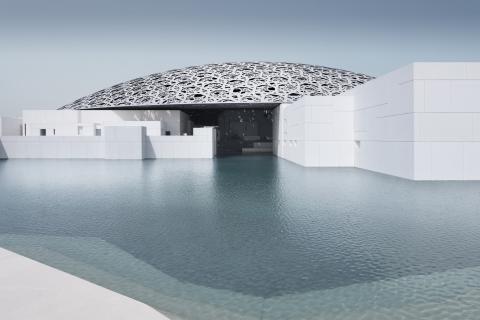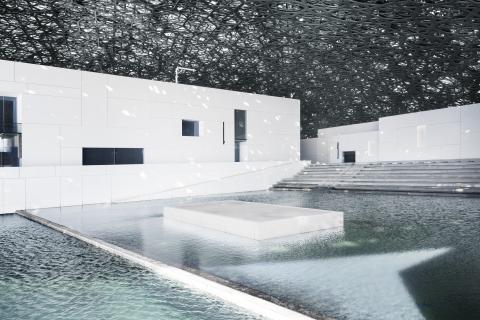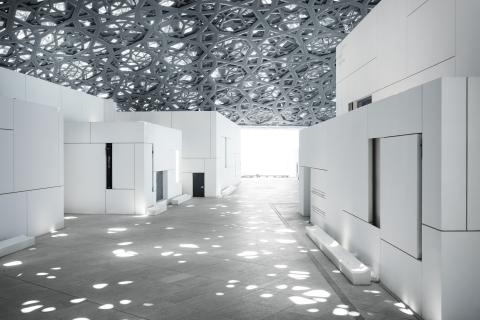This wonderful Cornish workshop and museum is dedicated to the legacy of studio pottery trailblazer Bernard Leach
Humanity: A global project
Humanity: A global project
21 Nov 2017
The first of three major cultural institutions planned for Abu Dhabi’s Saadiyat Island opens its doors this November, marking a defining moment in an ambitious vision to bring a suite of internationally regarded museums to the United Arab Emirates (UAE). Louvre Abu Dhabi, which promises visitors nothing less than seeing ‘humanity in a new light’, is the culmination of 10 years’ collaboration between the city’s Tourism & Culture Authority and the Agence France-Muséums, an organisation that was set up specifically to deliver this project. The agreement includes exhibitions provided by several major French collections, on loan for the next 15 years.
Situated on one of the UAE’s several hundred outlying islands, the museum forms an archipelago of 55 buildings (23 are galleries, the others include a separate Children’s Museum, research centre, auditorium and café) and is accessible by both land and sea. French architect Jean Nouvel looked to classic Islamic architecture – specifically the aesthetics of ancient fortified town centres known as medinas – when conceiving this low-lying cluster of structures, envisaging a ‘museum city’ as opposed to a monolith.
The defining flourish is a vast, 180m-wide latticed dome that shelters this manufactured neighbourhood, creating a ‘rain of light’ through layers of punctured geometric shapes arranged like stars. Their inspiration lies in traditional pierced screens known as mashrabiya.
Once inside, Louvre Abu Dhabi tells a story that stretches from pre-history to contemporary art, with approximately half of the 600 objects on display taken from its established permanent collection, with the remaining majority lent by French institutions and other international names, including the National Gallery of Art in Washington and the Kimbell Art Museum in Texas.
The Louvre Abu Dhabi collection was founded with a Mondrian painting bought from the Yves Saint Laurent and Pierre Bergé collection sale back in 2009, but now features hundreds of pieces acquired from throughout the world. Highlights include a Bactrian princess sculpture dating back to the early second millennium BC; Giovanni Bellini’s Madonna and Child (1480–5); and an action painting named 1960, by Kazuo Shiraga.
In keeping with the commitment made by director Manuel Rabaté to be ‘the world’s first universal museum’, displays have been arranged with an emphasis on chronology as well as thematics. This offers visitors the chance to see the interplay between global artistic exchanges that have existed for as long as the most ancient of trade routes have been in operation. New sitespecific commissions have also been installed outdoors, including a vast bronze tree created by Giuseppe Penone and a series of engraved stone walls that cite significant historical texts, courtesy of Jenny Holzer.
The first temporary exhibition opens in December. Entitled From One Louvre to Another, and curated by Jean-Luc Martinez, it will focus on the history of the Louvre in Paris, first as a royal collection and then as a public museum, as well as offering a behind-the-scenes look at how the Abu Dhabi museum was built and its collection amassed. Such a show puts the final stamp on this decade-long endeavour, which can only serve as an impetus for the as-yet unrealised plans for the Zayed National Museum and a new Guggenheim.
On completion, the three institutions will form Saadiyat’s core art triad (to be joined later by a second phase of construction that has promised a maritime museum and an enormous performing arts centre). This triangle will act as a massive cultural injection for Abu Dhabi and beyond, serving the demands of its ever-growing affluent communities and thriving international tourism.
Although building has yet to begin on the Zayed National Museum and the new Guggenheim, both projects have already garnered attention for their hugely ambitious architectural design. Frank Gehry and Norman Foster have been selected to conceive the Guggenheim and the Zayed respectively, so there is no doubt that these museums will be every bit as magnificent as the Louvre.
Gehry has shared at least a passing conceptual vision with Nouvel. His building also looks to ancient settlements as a source of inspiration, though the similarity might not be immediately forthcoming. The plans for this enormous structure – guaranteed to be the largest Guggenheim to date, at roughly 12 times the size of its New York counterpart – resemble a tumbled mass of blocks and cones, with ‘monumental piles of gallery boxes’ connected by a series of glass bridges and a gigantic covered courtyard.
The museum will serve as a temple to modern art, taking a ‘transnational’ view of every conceivable medium, from the 1960s to the present day. The collection has already developed without any firm assurances as to when the new outpost will be ready, but its presence has already been felt in the area via a series of temporary exhibitions in the Manarat Al Saadiyat – another arts enterprise that opened on the island back in 2010.
If Nouvel and Gehry have been influenced by lowlying settlements, then Foster has considered the exact opposite. His plans for the Zayed National Museum envisage five soaring towers that recall the shape of bird wings, inspired by the UAE’s rich history of falconry. This hunting method was favoured by Bedouin communities and continues to be a well-loved tradition throughout the country. It was also a favourite past-time of Sheikh Zayed bin Sultan Al Nahyan, the progressive leader who oversaw the formation of the Federation in 1971 and nurtured his country from a dominant rural economy to one of unprecedented wealth and technological advancement.
His eponymous museum stands apart as a predominantly inward-looking institution, with permanent galleries telling the national story through the lens of his legacy. These include an examination of the Islamic faith in the context of his social policies; a survey of his conservation activities (including the establishment of sustainable falconry); and an in-depth look at his radical schooling reform.
Of all the benefits that this new cultural hub promises, education remains at the forefront of Emirati consciousness. In fewer than 50 years, the city of Abu Dhabi has changed beyond recognition, with shopping mega centres, amusement parks and vast hotels serving as a beacon for the country’s huge economic growth. But while skyscrapers continuously encroach on desert plains, the national community has remained somewhat starved of significant cultural nourishment. Saadiyat Island changes all of that. While most countries might count a boost in tourism as one of its primary goals when establishing a new arts quarter, the UAE understands how vital it is to develop a cultural infrastructure that matches its rapid economic growth.
The opening of Louvre Abu Dhabi marks the beginning of this new era. While foreign visitors have the opportunity to view the art historical canon in a new, decidedly international light, the local community gains access to an unprecedented plethora of objects and world-class scholarship that was almost entirely inaccessible before.
Dr Lamees Hamdan, who commissioned the first UAE pavilion at the Venice Biennale back in 2009, counts this new educational milestone as a defining moment in her country’s history. “I am the mother of four children, and it is amazing to have a world-class museum on our doorstep. A lot of people don’t realise that the children of the UAE didn’t have a [major] museum to see artefacts from all over the world. It’s extraordinary for long-term education and appreciation of arts and culture. We don’t have that many artists yet, but it’s about time we started.”
Photos Courtesy Mohamed Somji
About the Author
Holly Black
JOIN OUR MAILING LIST
Become an instant expert!
Find out more about the arts by becoming a Supporter of The Arts Society.
For just £20 a year you will receive invitations to exclusive member events and courses, special offers and concessions, our regular newsletter and our beautiful arts magazine, full of news, views, events and artist profiles.
FIND YOUR NEAREST SOCIETY
MORE FEATURES
Ever wanted to write a crime novel? As Britain’s annual crime writing festival opens, we uncover some top leads
It’s just 10 days until the Summer Olympic Games open in Paris. To mark the moment, Simon Inglis reveals how art and design play a key part in this, the world’s most spectacular multi-sport competition






